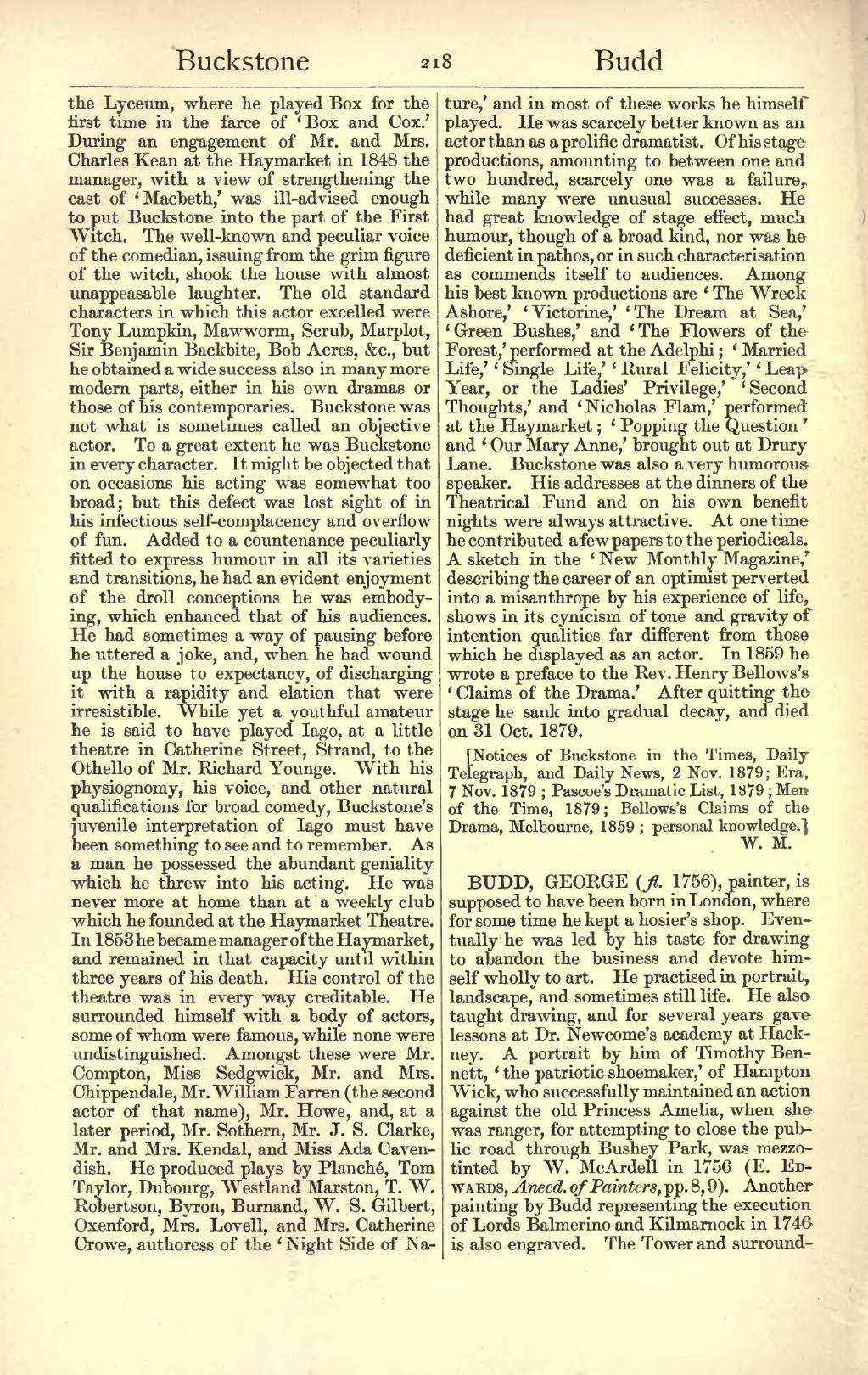the Lyceum, where he played Box for the first time in the farce of ‘Box and Cox.’ During an engagement of Mr. and Mrs. Charles Kean at the Haymarket in 1848 the manager, with a view of strengthening the cast of ‘Macbeth,’ was ill-advised enough to put Buckstone into the part of the First Witch. The well-known and peculiar voice of the comedian, issuing from the grim figure of the witch, shook the house with almost unappeasable laughter. The old standard characters in which this actor excelled were Tony Lumpkin, Mawworm, Scrub, Marplot, Sir Benjamin Backbite, Bob Acres, &c., but he obtained a wide success also in many more modern parts, either in his own dramas or those of his contemporaries. Buckstone was not what is sometimes called an objective actor. To a great extent he was Buckstone in every character. It might be objected that on occasions his acting was somewhat too broad; but this defect was lost sight of in his infectious self-complacency and overflow of fun. Added to a countenance peculiarly fitted to express humour in all its varieties and transitions, he had an evident enjoyment of the droll conceptions he was embodying, which enhanced that of his audiences. He had sometimes a way of pausing before he uttered a joke, and, when he had wound up the house to expectancy, of discharging it with a rapidity and elation that were irresistible. While yet a youthful amateur he is said to have played Iago, at a little theatre in Catherine Street, Strand, to the Othello of Mr. Richard Younge. With his physiognomy, his voice, and other natural qualifications for broad comedy, Buckstone's juvenile interpretation of Iago must have been something to see and to remember. As a man he possessed the abundant geniality which he threw into his acting. He was never more at home than at a weekly club which he founded at the Haymarket Theatre. In 1853 he became manager of the Haymarket, and remained in that capacity until within three years of his death. His control of the theatre was in every way creditable. He surrounded himself with a body of actors, some of whom were famous, while none were undistinguished. Amongst these were Mr. Compton, Miss Sedgwick, Mr. and Mrs. Chippendale, Mr. William Farren (the second actor of that name), Mr. Howe, and, at a later period, Mr. Sothern, Mr. J. S. Clarke, Mr. and Mrs. Kendal, and Miss Ada Cavendish. He produced plays by Planché, Tom Taylor, Dubourg, Westland Marston, T. W. Robertson, Byron, Burnand, W. S. Gilbert, Oxenford, Mrs. Lovell, and Mrs. Catherine Crowe, authoress of the ‘Night Side of Nature,’ and in most of these works he himself played. He was scarcely better known as an actor than as a prolific dramatist. Of his stage productions, amounting to between one and two hundred, scarcely one was a failure, while many were unusual successes. He had great knowledge of stage effect, much humour, though of a broad kind, nor was he deficient in pathos, or in such characterisation as commends itself to audiences. Among his best known productions are ‘The Wreck Ashore,’ ‘Victorine,’ ‘The Dream at Sea,’ ‘Green Bushes,’ and ‘The Flowers of the Forest,’ performed at the Adelphi; ‘Married Life,’ ‘Single Life,’ ‘Rural Felicity,’ ‘Leap Year, or the Ladies' Privilege,’ ‘Second Thoughts,’ and ‘Nicholas Flam,’ performed at the Haymarket; ‘Popping the Question’ and ‘Our Mary Anne,’ brought out at Drury Lane. Buckstone was also a very humorous speaker. His addresses at the dinners of the Theatrical Fund and on his own benefit nights were always attractive. At one time he contributed a few papers to the periodicals. A sketch in the ‘New Monthly Magazine,’ describing the career of an optimist perverted into a misanthrope by his experience of life, shows in its cynicism of tone and gravity of intention qualities far different from those which he displayed as an actor. In 1859 he wrote a preface to the Rev. Henry Bellows's ‘Claims of the Drama.’ After quitting the stage he sank into gradual decay, and died on 31 Oct. 1879.
[Notices of Buckstone in the Times, Daily Telegraph, and Daily News, 2 Nov. 1879; Era, 7 Nov. 1879; Pascoe's Dramatic List, 1879; Men of the Time, 1879; Bellows's Claims of the Drama, Melbourne, 1859; personal knowledge.]
BUDD, GEORGE (fl. 1756), painter, is supposed to have been born in London, where for some time he kept a hosier's shop. Eventually he was led by his taste for drawing to abandon the business and devote himself wholly to art. He practised in portrait, landscape, and sometimes still life. He also taught drawing, and for several years gave lessons at Dr. Newcome's academy at Hackney. A portrait by him of Timothy Bennett, ‘the patriotic shoemaker,’ of Hampton Wick, who successfully maintained an action against the old Princess Amelia, when she was ranger, for attempting to close the public road through Bushey Park, was mezzotinted by W. McArdell in 1756 (E. Edwards, Anecd. of Painters, pp. 8, 9). Another painting by Budd representing the execution of Lords Balmerino and Kilmarnock in 1746 is also engraved. The Tower and surround-
